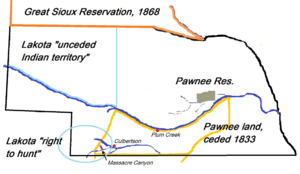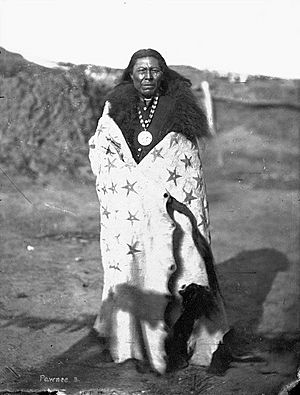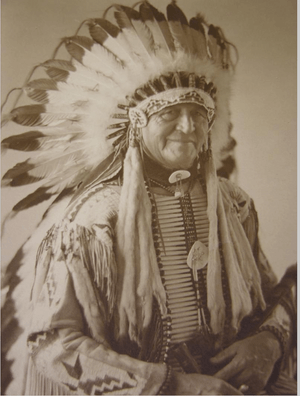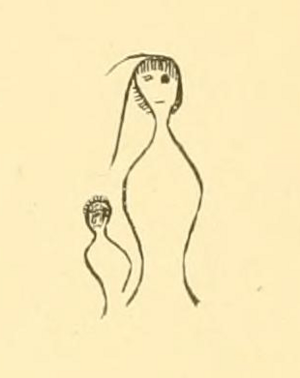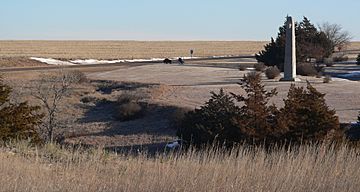Massacre Canyon facts for kids
Quick facts for kids |
|
|
Massacre Canyon Battlefield
|
|
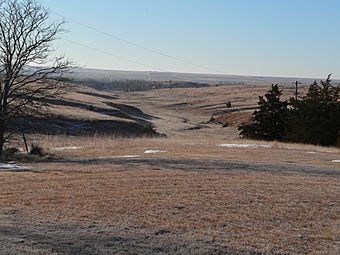
View looking southwest from the Massacre Canyon monument
|
|
| Nearest city | Trenton, Nebraska |
|---|---|
| Area | 3,680 acres (1,490 ha) |
| NRHP reference No. | 74001118 |
| Added to NRHP | July 25, 1974 |
The Massacre Canyon battle happened in Nebraska on August 5, 1873. It took place near the Republican River. This was one of the last big fights between the Pawnee and the Sioux (also known as Lakota). It was also the very last major battle between Native American tribes on the Great Plains in North America.
The battle occurred when a large group of over 1,500 Oglala and Brulé Sioux warriors attacked. They were led by chiefs Two Strike, Little Wound, and Spotted Tail. They attacked a group of Pawnee who were on their summer buffalo hunt. Many Pawnee were killed in the attack, possibly more than 150.
John W. Williamson, a Quaker agent, said that 156 Pawnee died. This event was one of the "bloodiest attacks by the Sioux" in Pawnee history. The Lakota Sioux had fought fiercely against the Pawnee for centuries, from the mid-1700s to the 1840s. These attacks became even more frequent from the 1850s until 1875. The Pawnee eventually had to give up their remaining land in Nebraska to the U.S. Government. This happened because they realized the government would not keep its promises from earlier treaties. Pawnee villages and the Quaker agency near Genoa had been attacked by the Lakota before, without the U.S. Government's promised protection.
According to John W. Williamson, who was with the Pawnee hunting party, about 700 Pawnee left Genoa for the hunting grounds on July 3, 1873. About 350 of them were men, and the rest were women and children.
The Pawnee were moving along the west side of the canyon when the attack happened. The canyon runs south to the Republican River. Over 150 Pawnee were killed. Some people believe this massacre was one reason the Pawnee decided to move to a reservation in Indian Territory (which is now Oklahoma). However, the Pawnee themselves do not agree with this idea.
Important chiefs during the battle included:
- Pawnee: Sky Chief, Sun Chief, Fighting Bear, Ruling His Son.
- Sioux: Spotted Tail (Brulé chief) (his role is unclear), Little Wound (Oglala chief), Two Strike (Brulé chief). Chief Charging Bear (John Grass, Sihasapa) might also have been there.
Among the Pawnee who died was Sky Chief (Tirawahut Lesharo). He was surrounded and killed by the Sioux while skinning a buffalo. The wife and four children of Traveling Bear also died. Traveling Bear was a former sergeant in the Pawnee Scouts and a Medal of Honor winner.
| Massacre Canyon Battle | |||||||
|---|---|---|---|---|---|---|---|
|
|||||||
| Belligerents | |||||||
| Brule Lakota Indians Oglala Lakota Indians | Pawnee Indians | ||||||
| Commanders and leaders | |||||||
| Little Wound, Two Strike | Sky Chief, Fighting Bear, Ruling His Son | ||||||
| Strength | |||||||
| Around 1,000 Lakotas | Around 400 all in all, children, women and men | ||||||
| Casualties and losses | |||||||
| Unknown, but few | Unknown, but likely between 65 and 100, mostly women and children | ||||||
Contents
History of the Pawnee and Sioux
The Pawnee Indians had lived in what is now Nebraska for a very long time. They first gave up land to the United States in 1833. This land was south of the Platte River. The Massacre Canyon battlefield is located in this area. Forty years later, the Pawnee lived on a small reservation in Nance County.
The Pawnee still had the right to hunt buffalo on their large, old hunting grounds. These lands were between the Loup, Platte, and Republican rivers in Nebraska. They also extended south into northern Kansas. However, the Sioux constantly attacked them, and these attacks became much worse in the early 1840s.
The Sioux lived north of the Pawnee. In 1868, they signed a treaty with the United States. They agreed to live on the Great Sioux Reservation in what is now South Dakota. This treaty also gave them the right to hunt along the Republican River, which was almost 200 miles south of their reservation.
Both the Pawnee and the Sioux often complained about attacks from the other tribe. In 1871, the United States tried to help them make peace, but it did not work.
Events Leading to the Battle
On August 4, 1873, a Pawnee hunting group was camped near what is now Trenton. There were about 400 people, including men, women, and children. Trail Agent John W. Williamson was with them, along with a visitor named Lester Beach Platt. They were all heading back to their reservation after a successful hunt.
Sioux chiefs Little Wound and Pawnee Killer had been hunting further west. In July, their sub-agent, Antoine Janis, stopped them from attacking the Utes. The Sioux camp then moved closer to the Republican River.
Around 700 Brule-Sioux Indians were also hunting buffalo in Nebraska in early August. Chief Two Strikes and Sub-agent Stephen F. Eastes were with them.
On August 3, some Oglalas brought news of the large Pawnee camp. Chief Little Wound told Antoine Janis that he had stopped his young men from fighting the Utes. But now, "the young men had decided to fight" the Pawnees. Janis said he had no orders to stop them from fighting the Pawnee there. His idea to meet and talk with the Pawnee was rejected. He later said that trying to stop the warriors was like trying to "stop an avalanche."
All the Sioux tipis in the area heard the news. A boy who saw it happen remembered years later that "instantly all the warriors began to get ready to go on the warpath." He understood that the warriors were defending their hunting grounds. During the day, about 1000 warriors left to attack the Pawnee quickly, to prevent the Pawnee from attacking first.
Trail Agent Williamson's Story
John Williamson was 23 years old and worked as the Pawnee trail-agent at the Genoa Agency. He went with the Pawnee on their hunt. Years later, he wrote down what he remembered about the battle.
He said, "On August 4, we camped on the north bank of the Republican River. That evening, three white men came to our camp. They told me that a large group of Sioux warriors was camped 25 miles [40 km] northwest. They had been waiting to attack the Pawnees for several days. They expected us to move up the river where buffalo were. Other white men had warned us before to be careful of Sioux attacks. So, I was a bit unsure if this story was true. But one of the men, a young man my age, seemed very serious. He really wanted me to believe the warning. So, I took him to Sky Chief, who was in charge that day, to talk. Sky Chief said the men were liars. He thought they wanted to scare the Pawnees away so white men could hunt buffalo for hides. He told me I was a 'squaw' and a 'coward.' I disagreed with him and said, 'I will go as far as you dare go. Don't forget that.'"
Williamson continued, "The next morning, August 5, we left camp and headed north. We went up the high land between the Republican and Frenchman Rivers. Soon after we left, Sky Chief rode up to me and held out his hand. He said, 'Shake, brother.' He remembered our disagreement from the night before. He said he didn't think there was anything to worry about. He was so sure that he had not sent out scouts in the direction the Sioux were reported to be. A few minutes later, a buffalo scout signaled that buffalo had been seen far away. Sky Chief rode off to join the hunt. I never saw him again. He had killed a buffalo and was skinning it when the first Sioux warriors shot and wounded him. The Chief tried to get to his horse, but before he could get on, several enemies surrounded him. He died fighting. A Pawnee, who was skinning a buffalo nearby but managed to escape, told me how Sky Chief died."
The Battle Begins
On the morning of August 5, the Pawnees went up a canyon. Men looking for game went first, and the families followed with horses carrying their supplies. Soon after, the battle began.
Many of the Pawnee hunters in front were likely the first to die. They were tricked into a Sioux trap by a decoy.
The Pawnee got ready to defend themselves. Williamson, with either Platt or the educated Pawnee Ralph Weeks, rode out to try and arrange a peace talk. But bullets forced them back.
The Pawnees say that Sky Chief was alive during the first part of the battle. He fought for his tribe, shouting words of encouragement. He said, "Today I may see the tribe you protect here. This is the end. It is supposed to be better old men not to become. Now, men, a man be." He even killed his own small son with his knife. He told the Sioux that they would not get his child.
Sky Chief covered his people's retreat, and the Sioux surrounded him. He was alone and on foot. Dog Chief, Sky Chief's younger brother, rode through the Sioux line. He told Sky Chief to leave. Sky Chief refused to stop fighting while the enemies were killing Pawnee women and children. Knowing he would be killed, he took off his bear claw necklace. This necklace was a symbol of his leadership. He told Dog Chief, "Take the necklace and try to escape... I want you to have it and do not want the Sioux to gain possession of it." Dog Chief managed to get the necklace to safety.
The Pawnee version of the Massacre Canyon battle tells stories of what happened to a few people and some unusual events.
The Sioux were too strong. Women threw hides, dried meat, and saddles from their packhorses. The Pawnee began a messy retreat. "The retreat was a complete escape as the Sioux shot from both sides of the canyon into the fleeing Pawnee." In Culbertson, ten miles east of the battlefield, people heard the sound of gunfire.
East of Culbertson, Captain Charles Meinhold and his small group from Fort McPherson were camped by chance. Throughout the morning, Pawnee survivors, as well as Williamson and Platt, reached the camp. Platt had escaped early in the fight. The Pawnees were told to go further east.
After the Battle
In the afternoon, the white men rode up the canyon. Platt remembered, "The first body we came upon was that of a woman." Army Dr. David Franklin Powell described walking through the battleground: "We went from the mouth of the ravine to its head and found fifty-nine dead Pawnees..."
Sometime after the battle, the Sioux warriors rode into their camps. "One of the men in front was waving a scalp. This caused great excitement. The men marched around the village... Everyone seemed happy and celebrating." Later, the well-known Sioux Indian Luther Standing Bear thought that "about three hundred Pawnees were killed." Eastes reported one Sioux killed and some badly wounded. The Cut-off Oglalas had no casualties, according to their sub-agent. This does not match other stories of what happened in the canyon that day.
People from nearby towns visited the battle site in the days that followed.
News of the defeat reached the remaining Pawnees on the reservation on August 8. A runner brought the news. "This caused strong feelings in the village; sad cries were heard all day."
The Pawnee survivors traveled about 80 miles to Plum Creek near the Platte River. Here, Dr. William M. Bancroft helped the wounded. They then took a train to Silver Creek, about ten miles south of the Pawnee Agency. The Pawnee's last tribal buffalo hunt in Nebraska ended soon after.
Later Events
In the last week of August, Williamson returned to Massacre Canyon. He covered the dead bodies with dirt from the banks.
Pawnees who had been captured were released after white people asked for them. They soon rejoined their tribe.
The Pawnee received $9,000 for losing more than 100 horses, 20 tons of dried meat, and all their equipment. This money came from the Sioux's annuities, as stated in the 1868 Sioux Treaty.
This event, in particular, made the government try harder to keep Native Americans on their reservations. This was to stop fighting between tribes. Locally, Major General George Crook sent a small group of soldiers to protect the Pawnee Agency. However, the soldiers' presence did not stop the Sioux raids.
In the Lakota winter count of Cloud-Shield, the victory is remembered as the winter "they killed many Pawnees on the Republican river." The Pawnee Indians call it "The hunters that were massacred."
Dog Chief, who was young, gave his dead brother's bear claw necklace to the son of Indian Agent Burgess for safekeeping. Some Pawnees tried to get it back but failed. In 1920, Chawi Pawnee chief Lone Chief visited Burgess in Chicago and brought the necklace back.
It was fifty years after the battle before the Pawnee and the Sioux made peace. They smoked the pipe of peace during the Massacre Canyon Pow Wow in 1925.
Massacre Canyon Monument
The Massacre Canyon Monument was officially opened on September 26, 1930. It was the first historical monument in Nebraska built with money from the federal government. It stands on a three-acre (1.2 ha) plot of land. It is three miles (4.8 km) east of Trenton, just off U.S. Route 34. It was moved from its first spot, which overlooked the Republican River valley. The monument was made from pink granite from a quarry in St. Cloud, Minnesota. R.P. Colling from Indianola, Nebraska, built it. The tall, pointed part of the obelisk is 35 feet (11 m) high. The base is 9 feet (2.7 m) by 9.5 feet (2.9 m) across. The bottom of the main shaft is five feet (1.5 m) wide, getting narrower to 32 inches (81 cm) near the top. The entire monument weighs 91 tons (83,000 kg).
The monument is in a small park area. The park has picnic tables and a visitor center. The visitor center has exhibits about early pioneers, the customs of the Sioux and Pawnee people, and a gift shop.




